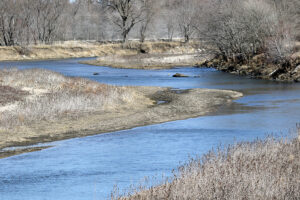Iowa primed for potentially ‘epic’ increase in stream pollution

The North Raccoon River routinely has elevated levels of nitrate contamination. (Photo by Jared Strong/Iowa Capital Dispatch)
by Jared Strong, Iowa Capital Dispatch
February 29, 2024
A buildup of nitrate in farm fields that has likely resulted from Iowa’s longest-running drought in 70 years has set the stage for a potentially massive uptick in stream pollution, state water-quality observers say.
Research has shown that nitrogen fertilizer that goes unused by crops can be quickly flushed from those fields after a drought year, and Iowa’s drought has been ongoing for more than three.
The nitrate leach is often most pronounced during significant spring rains when fields have been fertilized but crops aren’t yet growing.
“These extreme events are quickly becoming the rule,” said Chris Jones, a former University of Iowa researcher who studies agriculture’s effects on water quality. “If and when we return to this wet regime, it’s going to be epic.”
An example: In 2013, record spring rainfall lifted the state from one of its worst droughts. The result was a more than 400% increase in the amount of nitrate that was detected in Iowa streams from 2012 to 2013, according to data collected by the Iowa Nutrient Research Center.
With stream flow data taken into account, 2013 was nearly the worst in two recent decades for nitrate pollution. The absolute amount of nitrate in streams statewide trended upward until 2016.
Climate predictions show that this spring might be warmer and wetter than normal, State Climatologist Justin Glisan said. That increases the likelihood of thunderstorms and their heavier rainfalls, but he said it’s impossible to say whether this spring will mimic 2013.
More nitrate in 2022
Nitrogen is a key nutrient for Iowa corn to ensure maximum crop yields. It is often added to fields with synthetic fertilizers and livestock manure.
But it poses environmental threats beyond the fields. Rivers are a significant source of drinking water for large cities — notably those in the Des Moines metro area — and nitrate must sometimes be removed from that water to make it safe to drink. Des Moines Water Works spent about $150,000 on nitrate removal in 2022.
Further, elevated levels of nitrate and another prominent nutrient — phosphorus — can wreak havoc on aquatic ecosystems, leading to algae blooms that diminish oxygen in the water and release toxins that are harmful to swimmers.
The crop fertilizers are leading contributors to the Gulf of Mexico’s dead zone.
The release of nitrate into Iowa’s streams is expedited by the state’s expansive network of underground tiling. Those perforated pipes drain soggy fields to improve crop production but also provide a quicker pathway for nitrate into streams.
About half of the state’s cropland is drained by tile, according to Iowa State University, and farmers continue to install more.
(A recently released survey by the U.S. Department of Agriculture showed a decrease in underground tiling in recent years, but it’s unclear why.)
In drought years, the amount of nitrate and phosphorus in streams is expected to diminish. There is less water absorbing nitrate in the soil and less surface erosion, which causes phosphorus leaching.
That is reflected by the state’s stream monitoring data: There were decreases in nutrient loads in 2020 and 2021 to some of their lowest levels in two decades.
Parts of Iowa have been suffering from drought conditions since July 2020. About 79% of the state has some measure of drought now.
But in 2022 — the monitoring data for which was recently published by the state — there was an increase in stream nitrate. That’s despite 2022 having slightly less average rainfall statewide than 2021.
Matt Helmers, who leads the nutrient research center, attributes the jump to the buildup of nitrate during the drought and rains that fell in months when crops weren’t growing.
Just three months of 2022 had above-normal rainfall, according to state weather data: March, November and December. All of them fall outside of the state’s traditional crop growing seasons.
Commercial fertilizer sales also reached a new record in Iowa in 2022, according to the Cedar Rapids Gazette, and farmers have been increasingly fertilizing their fields in the fall. That creates potential for additional stream pollution because the nutrients are in the soil for longer periods of time when crops aren’t growing.
State ag officials have sought with greater fervor in recent years to help farmers implement edge-of-field conservation practices. The projects are meant to slow the release of surface runoff and underground water flows and to remove nutrients from them before they reach streams.
The impact of that work on the state’s overall water quality is not yet clear, Helmers said.
“The monitoring that folks are doing shows that those practices are effective, but we do need to recognize they’re still treating a pretty small percent of the landscape,” he said.
Stream monitoring survives budget cut
Last year, Republican lawmakers cut a third of the research center’s funding and moved it to the Iowa Department of Agriculture and Land Stewardship to help pay for the projects.
That annual $500,000 amount matched what the research center had devoted to operate the Iowa Water Quality Information System, which aggregates real-time nitrate contamination data. Opponents of the move feared it might doom the system.
“Without data, it will be easy to say there’s no problem or we don’t know how to measure the problem,” Sen. Janice Weiner, D-Iowa City, said last year.
Instead, the research center cut its funding of the system by a third. There is still enough money to operate its network of 70 monitoring sites, said Larry Weber, director of IIHR-Hydroscience and Engineering at the University of Iowa, which operates the system.
The monitoring sites are especially valuable because they provide continuously updating data about nitrate concentrations, Weber said, whereas other monitoring by the Iowa Department of Natural Resources happens once each month. (The DNR samples for a much wider range of contaminants.)
Data from both sets of monitoring sites are used by the nutrient research center to calculate annual nutrient loads.
While the funding cut isn’t expected to disrupt the UI monitoring network itself, it will impede the analysis of the data the network produces.
“It’s easy to collect data,” Weber said. “Our staff provide an incredible support to the Nutrient Research Center at ISU, which relies on our researchers to analyze and assess.”
Opinions on progress differ
The state’s nitrate data has shown an overall decline in stream pollution in recent years, but because of the drought it is difficult to discern which way the situation is trending overall. Opinions about that trend vary:
— Helmers, at the research center: “It’s hard to tell, year to year,” he said, adding that the so-called “batch and build” conservation program that was pioneered in the state in Polk County has led to a quicker adoption of edge-of-field practices.
That idea — to build bioreactors and buffers along multiple farms in a small region — has been co-opted by state ag officials and is now one of the primary chosen weapons against stream contamination.
“We still need to scale up,” Helmers said. “Get even more adoption of those practices.”
— Don McDowell, communications director for the state Department of Agriculture and Land Stewardship: “Iowans recognize that our variable weather will always introduce ups and downs as we move toward achieving our long-term Nutrient Reduction Strategy goals,” he said.
McDowell did not comment specifically on the department’s views of the long-term trends but said the state “has broken records for conservation and water quality adoption in each of the last two years.”
The state’s recent initiatives have more than doubled the dollars spent on conservation practices since the adoption in 2013 of the Nutrient Reduction Strategy, which prioritizes the voluntary efforts of farmers to curb their pollution. Its goal is to reduce the amount of nitrogen and phosphorus that leaves farm fields by 45%.
McDowell noted that farmers are now planting cover crops on nearly 4 million acres of cropland, up from relatively none a decade ago. Those crops are planted after harvest in fields that might otherwise be bare to control erosion and absorb nutrients that could go into streams. That acreage amounts to about 17% of the total that is planted with corn and soybeans each year.
“We know that these water quality practices work, and we are firmly committed toward accelerating the pace of their adoption,” McDowell said.
Farmers can be hesitant to change their practices because of the risks those changes pose.
“It may be a slower process than many would like, but from a perspective from the farmer, I’m jeopardizing my ability to stay in business if I make the bad decisions,” Roger Zylstra, a Jasper County farmer, has said.
— Alicia Vasto, water program director for the Iowa Environmental Council: “Things are not trending in the direction that everyone wants to say they are,” she said.
The council has criticized the state nutrient strategy and has estimated that it will take many decades to reach its goals based on the progress that has been made so far.
Vasto said that at a minimum, farmers should be required to create buffers between their fields and streams and that fertilizer applications should be more restricted.
— Jones, the former UI researcher and author: “I think there can be no doubt that the long-term trend for nitrogen is up,” he said. “At the same time that we’re implementing conservation, we’re also doing stuff to make it worse.”
That includes installing significant amounts of new drainage tile and increasing the use of fertilizers, he said.
“When you look at the new nitrogen load from the new tile, that dwarfs the conservation practices,” Jones said.
He said the best solution to the state’s water quality woes is to diversity what crops are grown — a seismic shift away from the well-entrenched focus on corn and soybeans that would require “retreating from ethanol.”
“Ethanol has got to die,” Jones said. “It just has to if we’re going to improve this environmental condition in Iowa.”
That is unlikely, at least in the foreseeable future. More than half of the state’s corn is used to produce ethanol, and state leaders have pushed to expand its use.
Further, carbon dioxide pipelines are potentially poised to increase the fuel’s longevity despite federal goals to shift to electric cars.
A state report on the status of Iowa’s waterways is due to the U.S. Environmental Protection Agency in the coming weeks. That update, which is required every two years, will list the streams, lakes and wetlands the Iowa Department of Natural Resources deems “impaired.” The impairments can include contamination by nitrate and other pollutants, elevated bacteria counts and lackluster fish populations and diversity, among others.
In its 2022 assessment, the DNR noted more than 750 impaired waters.
Iowa Capital Dispatch is part of States Newsroom, a nonprofit news network supported by grants and a coalition of donors as a 501c(3) public charity. Iowa Capital Dispatch maintains editorial independence. Contact Editor Kathie Obradovich for questions: info@iowacapitaldispatch.com. Follow Iowa Capital Dispatch on Facebook and Twitter.












